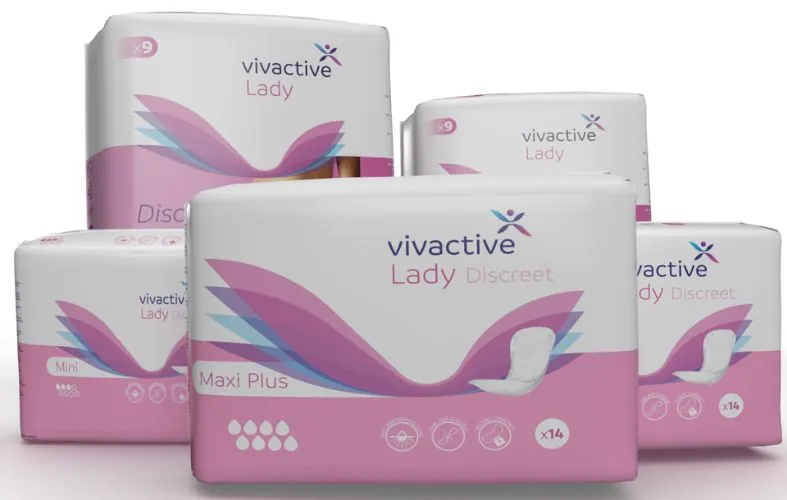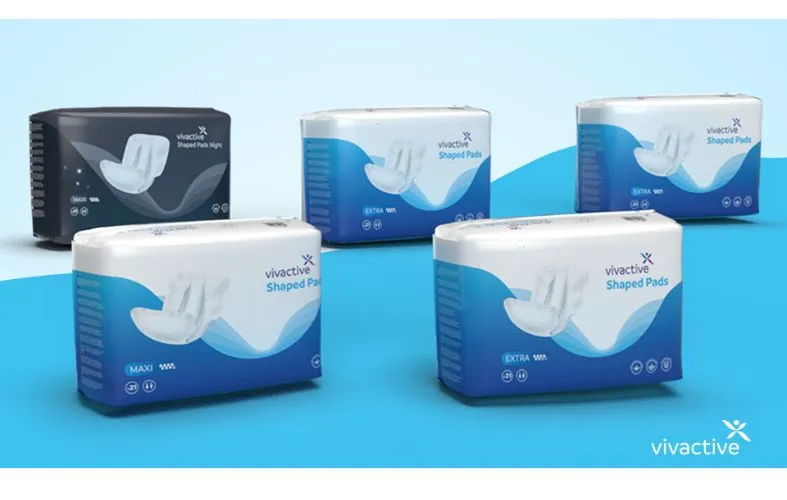
Share this page with friends
How often should you change your incontinence pads?
Different pads for different needs
- Large shaped pads
- Discreet pads
How often should you change discreet pads
Discreet pads, as you may have guessed by the name, are built with discretion in mind. They tend to be smaller than large-shaped pads and are usually worn inside your regular underwear. The absorbency levels of discreet pads are lower than what you might find with large-shaped pads, but what they lack in absorbency they make up for in discretion and mobility.
Due to their smaller size, they’ll probably need to be changed more often. Generally speaking, you won’t need to change your pad after every little leak. It’ll really depend on how much urine you’re leaking. For example, if you pick up a Vivactive Lady Discreet Maxi, you’re looking at 1000ml absorbency. Whereas a lower absorbency version, like the Lady Discreet Mini, will absorb 320ml of urine. So, if you’re using the Mini, you’re likely to fill the pad much faster than the higher absorbency Maxi version.
If you’re only experiencing light leaks, you probably won’t need to immediately change your pad. They’re super-absorbent, so the pad will suck in light leaks and lock them away, minimising any dampness. You’ll likely get away with a few small accidents before you need to change your pad. A lot of people think you need to change the pad straight away after every small leak, but you really don’t need to. For heavier leaks, you might want to consider using the higher absorbency pads, but again, it’s likely you’ll be able to get a couple of uses out of them before needing to dispose of and replace them.
The big exception to the rule is faeces. If you get any faecal matter in your pad, you need to change it straight away.
If you’re looking for a small, discreet solution to soak up leaks while you’re on the go, Vivactive Lady Discreet Pads will be your best friend. Designed for subtlety, these pads are small and fit comfortably inside your regular underwear. Their small size means they’ll sit snug inside your handbag, so you can take a few with you.
Discreet pads are essential for your handbag. They’re easy to get in and out, so there’s minimal faff when it comes to putting them on. You can carry them with you everywhere and their discreet packaging means nobody needs to know what they are.
We’re slowly becoming a much more open society with traditionally taboo subjects like incontinence. Even so, not everyone is super confident about their bladder weakness. If you’re not someone who wants to broadcast their bladder leaks from the rooftops, discreet pads will ensure nobody knows you’re wearing them.
Vivactive Lady Discreet pads are designed with a 50% thinner profile and feature our advanced TRIPLE LAYER LOCK™ technology, which rapidly absorbs liquid and locks in odour. Plus, they cost up to 50% less than similar products you might find in supermarkets or pharmacies.
At Vivactive, we’re all about value. Thanks to our product experts and online-only approach, we can pass on all of our savings to you. So, get yourself a pad that beats the competition, at a cheaper price.

How often should you change Large Shaped Pads
Large-shaped pads are a heavy-duty option, built specifically to handle big leaks. Their huge absorption capabilities and traditionally bulky design mean they’re geared mostly toward people with chronic incontinence and people who are less mobile.
Due to their large absorbency capacity, generally speaking, you probably won’t need to change them after every leak. But, you’ll want to change them before they reach their absorbency limit. Of course, like the discreet pads, they vary in absorbency levels. If you’re leaking huge volumes of urine then you’ll probably want to change them as soon as the wetness indicator is showing. What we don’t want is to overfill the pad. Most people think you need to change them straight away, but that’s not always true. If you’re usually wearing a big absorbency pad, but only experiencing small to moderate leakage, you’ll get more wear out of your pad.
The big exception to the rule is faeces. If you get any faecal matter in your pad, you need to change it straight away.
With hundreds of 5-star reviews, Vivactive Shaped Pads Maxi are an incontinence pad that customers love. These fantastic incontinence pads absorb liquid up to 25% faster than some other brands.
They’re packed full of industry-leading incontinence technologies such as TRIPLE LAYER LOCK™ and hydrophobic leg cuffs to keep you secure and comfortable.

Why is it important to change your incontinence pads?
Avoiding skin irritation
If urine sits against your skin for long periods of time, it can irritate your skin and cause some hygiene issues. A good incontinence pad will draw liquid away from the skin almost instantly, locking it away inside the absorbent core. But, if you start to reach the limit of the pad’s absorbency, you might find your next urine leak isn’t absorbed properly, forming prolonged contact with your skin. So, you’ll want to change your pad before it reaches its limit. You’ll be able to gauge this yourself by looking at the product specs.
Generally speaking, most providers will say you should change your pad roughly 3 times a day. But, as we’ve talked about in this article it’s not always that clear cut. If your pad is dry and you feel comfortable, why change it?
Preventing odours
While modern incontinence pads are designed to minimise odours, leaving a saturated pad for too long can lead to unpleasant smells. Changing your pad regularly helps maintain freshness and keeps you feeling confident and comfortable throughout the day. Nobody wants to be self-conscious about unwanted odours, and changing your pad regularly can help prevent this.
Reducing the risk of infections
Prolonged contact with urine can increase the risk of urinary tract infections (UTIs) and other skin infections. Regularly changing your incontinence pad helps maintain hygiene and reduces the likelihood of bacteria build-up, keeping your skin healthy and protected.
Maintaining comfort and confidence
Wearing a fresh, clean pad helps you feel comfortable and confident. A soggy or overflowing pad can be uncomfortable, bulky, and even embarrassing. Changing your pad regularly ensures you stay dry, comfortable, and confident throughout the day, allowing you to focus on the things that matter most.
How to change incontinence pads
Changing your incontinence pad might seem daunting at first, but it's a simple process once you get the hang of it. Here's a step-by-step guide:
- Find a private space: Choose a clean and private area, such as a bathroom or bedroom, where you can comfortably change your pad without feeling rushed or self-conscious.
- Wash your hands: Hygiene is crucial. Wash your hands thoroughly with soap and water before and after changing your pad. If soap and water aren't available, use hand sanitiser.
- Prepare your new pad: Unwrap your new pad and have it ready to go. If it has adhesive strips, peel off the backing paper.
- Remove the old pad: Carefully peel off the old pad from front to back, folding it in half to contain any leakage.
- Clean and dry the area: Gently cleanse the skin with mild, unscented wipes or a damp washcloth. Pat the area dry with a soft towel.
- Apply the new pad: Position the new pad correctly in your underwear, ensuring it's centred and comfortable. Fasten any adhesive tabs securely to your underwear.
- Dispose of the old pad: Wrap the old pad in a disposable bag or the wrapper from the new pad. Dispose of it in a sanitary bin or rubbish bin.
- Wash your hands again: Don't forget to wash your hands thoroughly once more to maintain hygiene.
Find the right incontinence pads for you
Now you know the answers to ‘how often should you change your incontinence pads?’ and ‘how to change incontinence pads?’, you can browse our online store to find the perfect fit for you. We have a large catalogue of incontinence pads available from many different brands, all offering great features that help support you every day!





